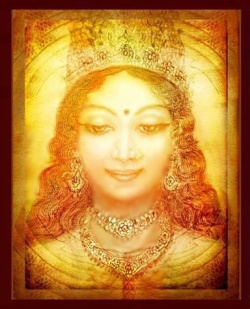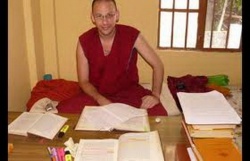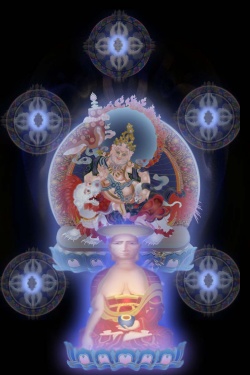Tibetan and Chinese Buddhisms
Tibetan and Chinese Buddhisms
By Indrajala (Jeffrey Kotyk)
Reading through the section entitled “Refuting Misconceptions About Meditation” in Lamrim Chenmo by Tsongkhapa (1357-1419) he discusses the erroneous idea, which as he states was common in his time, that analytical meditation is contrary to stabilizing meditation. He also states that this line of thinking is also the system of thought of the Chinese monk Ha-shang (in Chinese Heshang 和尚), who personifies in Tibetan Buddhist history the perceived inferiority of Chinese Chan. See the following quotes:
- "There are persons who have not begun to recognize that the classic scriptures and their commentaries constitute personal instructions, and who, therefore, might have the following qualm.
- Qualm: When you meditate on the path, you should do only stabilizing meditation rather than repeatedly analyzing your object of meditation, for repeated analysis with discerning wisdom is only for times of study and reflection. Moreover, repeated analysis will prevent you from future attainment of buddhahood because conceptual thought apprehends signs of true existence.
- Reply: This is nonsensical chatter of someone who is utterly ignorant of the crucial points of practice, for Maitreya's Ornament for the Mahāyāna Sūtras states:
- Proper attention is based upon prior study. Sublime wisdom, which takes reality as its object, arises from your cultivation of proper attention.
- Here Maitreya teaches that you should use the wisdom that comes from reflection to attend properly to the meaning of what you have studied. From this there will arise the wisdom that comes from meditation and perceives reality."[1]
He draws a parallel between this wrong conception of meditation with the infamous Chinese Ha-shang. As the story goes he lost the debate at Samye Monastery to Indian monks, whereupon it was decided that Tibet would only receive and adopt Indian forms of Buddhism. Whether this debate actually occurred or not is subject to debate, but as far as Tibetan cultural memory goes it happened.
- "Moreover, to claim that all conceptual thought involves the apprehension of signs of true existence, and thus prevents enlightenment, is the worst possible misconception as it disregards all discerning meditation. This is the system of the Chinese abbot Ha-shang. I explain its refutation in the section on serenity and insight. This misconception also interferes with the development of deep respect for classic texts, because these texts are mainly concerned only with the need to use discerning analysis, whereas Ha-shang's system sees all analysis as unnecessary during practice."[2]
Reading this it occurred me that another author of note Cheng'guan 澄觀 (738-839 CE) in the Tang Dynasty (618-907 CE), who lived in the same general era as when the Samye debate occurred where the infamous Ha-shang was brutally refuted, addresses the same issue in a rather small work of his entitled Examining the Five Aggregates 《五蘊觀》 where he outlines the practice of analyzing the five psycho-physical aggregates and in the concluding remarks refutes the same objection that Tsong Khapa does.
- 《五蘊觀》卷1:「問。夫求解脫。祗是了妄證真。但能契真如理。寂然無念則便離縛。何假興心觀蘊方求解脫。豈不乖理哉。答。離蘊真妄約何而立。且五蘊者身心之異名。行人若不識身心。真妄何能懸契。不達真妄之本。諸行徒施。故經云。若於虗空終不能成。斯之謂也。且計人我者。凡夫之執也。計法我者。二乘之滯也。故令修二觀。方能了妄證真。豈可離也。」
- 'It is asked, “Seeking liberation is only just understanding delusion and realizing the truth. It is merely being able to realize the principle of tathātā – in quietude without thoughts and then binds are removed. How does one provisionally arouse the mind, examine the aggregates and then seek liberation? Is this not in opposition to the principle?”
- We answer: with what do you stand without aggregates, truth and delusion? Furthermore, the five aggregates are a different name for the body and mind. Supposing the practitioner is not aware of the truth and delusions of body and mind, how could they completely understand them? They do not reach the source of truth and delusion and practises are vainly undertaken. Thus the scripture states, “It is like in emptiness ultimately nothing being able to be established.”[3] Furthermore, the conception of a self of a person is a delusional attachment for the ordinary person. The conception of the self of a phenomenon is an obstruction for the two vehicles. Thus we have them practice the two examinations and then they are able to understand delusion and realize the truth. How could you do without this?'[4]
This is noteworthy because the Samye debate is said to have occurred in the same time period as Cheng'guan was writing (8th century). We can indeed assume that some Buddhist thinkers in China at the time, perhaps those Cheng'guan had in mind, held the view of Ha-shang, but this was by no means a universal view held east of Tibet. I gather that in Tibetan Buddhism the views of Ha-shang are commonly thought of as “Chinese Buddhist views” and hence the whole of Chinese Buddhist thought can be easily dismissed and regarded as essentially defective. However, if we should just imagine that it was the scholar and yogi Cheng'guan who attended the debate at Samye, rather than this notorious Ha-shang character, then the perception of Chinese Buddhism in the general Tibetan Buddhist perspective might have evolved into a more positive image.
Fortunately, there has been some progressive development in recent times in clarifying long-held misconceptions between Chinese and Tibetan Buddhist traditions. There was a discussion held between His Holiness the Dalai Lama and Chan Master Sheng Yen in May 1998. Their discussion is recorded and translated in the publication Meeting of Minds. In the following quoted section the Dalai Lama notes the probable existence of two Chinese monks active in Tibet in the early history, and points out the source of the long-standing issue that, in general, Tibetan Buddhism has seemed to have had with Chinese Buddhism. He also notes Tsongkhapa's vocal criticism of Chan as he understood it.
- His Holiness:
- Earlier today in our private meeting, I was very impressed and pleased to hear that Venerable Sheng Yen once spent six years in solitary retreat. Listening to your presentation of Chan Buddhist teachings, my immediate and very profound feeling was that I was listening to words of wisdom from someone who is very experienced and a great practitioner. For all of us, to have knowledge of Dharma is indeed very important, but perhaps what is more important is to put that knowledge of Dharma into practice.
- Listening to your explanation of Chan Buddhism, I jotted down a few questions that I would like to ask. First, in which century did Master Huineng live?
- His Holiness:
- The reason I ask is that there is some historical connection to Chan in the origin and development of Tibetan Buddhism. We know that Lama Tsongkhapa had been one of the most vocal critics of the sudden teachings of Chan in Tibet, and there was a great debate surrounding Chan and the teachings transmitted from Indian Buddhism.
- However, in the Samye Temple during the formative era of Tibetan Buddhism in the reign of King Tri-song-Deutsen, different wings were devoted to different practices. One section is devoted to the Vajrayana practitioners-the tantricas. Another section is dedicated to the lozawas and the panditas-the translators and the scholars. The third section is called the dhyana hall, the place of meditation. This is supposed to have been the residence of a Chinese master referred to as Hoshang. It was during the eighth century, when Samye was built, that the Indian masters Santarakshita and Kamalashila were active in Tibet and were part of the development of Tibetan Buddhism.
- My feeling is that if Santarakshita built a separate wing in the Samye temple for the residence of the Chinese Chan masters, he must have welcomed that tradition and recognized it as an important element of Buddhism in Tibet. However, it seems that during the time of his disciple, Kamalashila, certain followers of Chan in Tibet perhaps promoted a slightly different version of the original doctrine. They placed tremendous emphasis on rejecting all forms of thought, not just in the context of a specific practice, but almost as a philosophical position. This is what Kamalashila attacked. Therefore, it seems to me, there were two different versions of Chan that came to Tibet.
- Venerable Sheng Yen:
- I am very grateful to His Holiness for bringing up the subject of the Chinese master Hoshang. From the story, it seems that those Chinese monks during the time of Kamalashila were not qualified to represent Chan. In the Dun Huang Caves, a place where many Buddhist texts were excavated, Buddhist scholars have found ancient texts relating a similar story about the first Chinese monk who greatly influenced Tibetan Buddhism, in particular the practice of meditation. So maybe the first Chinese master who went to Tibet wasn't so bad after all!
- His Holiness:
- In the Tibetan story, the first Chinese master was welcome; the second master supposedly lost the debate!
- Venerable Sheng Yen:
- So maybe the problem will not be with me, but with my successor who will again lose!
- His Holiness:
- Yes! From the Tibetan viewpoint, we welcome the first Hoshang. To the followers of the second Hoshang, we will have to say "good-bye!" If the Chinese masters that we encounter now are followers of the first Chinese master in Tibet, we will gladly receive them. If they are followers of the second Chinese master, we will have to say "farewell."[5]
Unfortunately, despite His Holiness' positive remarks, I do not foresee much serious interaction between Chinese and Tibetan traditions. I understand that in Taiwan Tibetan Buddhism is somewhat popular and I once met a Kagyu-pa Lama in 2010 when I was visiting the National Palace Museum in Taipei, who told me he was teaching in Taiwan. In the same afternoon I also saw some people handing out anti-Tibetan Buddhist literature, bilingual with Chinese and English, complete with shock images of tantric coupling deities, denouncing this as absolute heresy. The Dalai Lama has also been warmly received in Taiwan before, despite the objections of at least one major Buddhist leader in Taiwan, namely Venerable Xingyun of Foguangshan, objecting to his visits.
Still, while individuals themselves might take an interest and even practice Tibetan Buddhism, and there might be scholars who study Tibetan, I don't think an orthodox Chinese lineage would readily absorb many practices from their Tibetan cousins. Although at one point most of the Sinosphere (China, Korea and Japan) had its own form of Vajrayāna developed during the Tang Dynasty, it was eradicated on the mainland and only survives today in Japan with Shingon and Tendai, with small pockets of it also in Taiwan and America. However, it is yoga-tantra, and not being anuttara-yoga-tantra it lacks consort visualizations and practices. The former would be acceptable, but not the latter. Consort practices and even the artwork would not go over well, even for non-monastics, as orthodox Chinese Buddhism tends to be puritanical at times, really stressing celibacy even for ordinary laypersons. This all said, I am speaking of Chinese and Tibetan Buddhism as I understand it outside of the PRC – there might be some positive interaction between the two traditions in provinces like Gansu and Sichuan where you have both Han Chinese and Tibetans living in close proximity to each other.
In any case, I hope people can realize the value in taking an ecumenical approach to Buddhism. One need not limit oneself to just one cultural development of Buddhism as there is wisdom to be found all over the world.
Footnotes
- ↑ Tsong-kha-pa Blo-bzan-grags-pa, The Great Treatise on the Stages of the Path to Enlightenment. Volume One. Translated by the Lamrim Chenmo Translation Committee (Ithaca, NY: Snow Lion Publications, 2000), 109.
- ↑ Ibid., 112.
- ↑ Citation from the Vimalakīrti-nirdeśa-sūtra. 《說無垢稱經》卷1〈1 序品〉:「若於虛空終不能成」(CBETA, T14, no. 476, p. 559, a25)
- ↑ (CBETA, X58, no. 1004, p. 425, b23-c6 // Z 2:8, p. 303, a17-b6 // R103, p. 605, a17-b6)
- ↑ Meeting of Minds. Translated by Wang Ming Yee, Geshe Thubten Jinpa and Guo-gu. Edited by Lindley Hanlon and Ernest Heau. Dharma Drum Mountain, 35-38.




